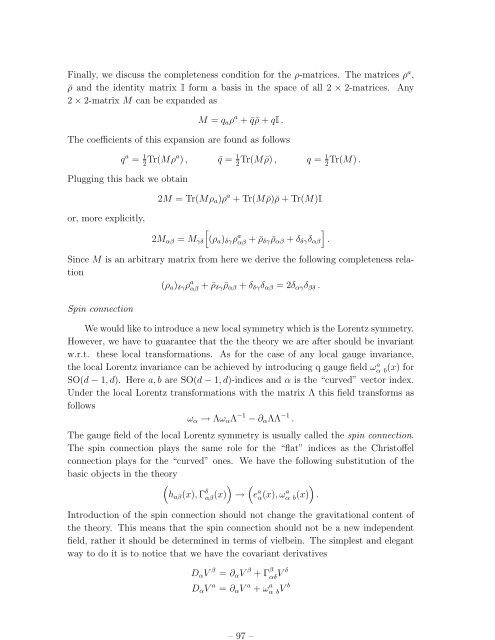Lectures on String Theory
Lectures on String Theory
Lectures on String Theory
Create successful ePaper yourself
Turn your PDF publications into a flip-book with our unique Google optimized e-Paper software.
– 97 –<br />
Finally, we discuss the completeness c<strong>on</strong>diti<strong>on</strong> for the ρ-matrices. The matrices ρ a ,<br />
¯ρ and the identity matrix I form a basis in the space of all 2 × 2-matrices. Any<br />
2 × 2-matrix M can be expanded as<br />
M = q a ρ a + ¯q¯ρ + qI .<br />
The coefficients of this expansi<strong>on</strong> are found as follows<br />
q a = 1 2 Tr(Mρa ) , ¯q = 1 2 Tr(M ¯ρ) , q = 1 2 Tr(M) .<br />
Plugging this back we obtain<br />
2M = Tr(Mρ a )ρ a + Tr(M ¯ρ)¯ρ + Tr(M)I<br />
or, more explicitly,<br />
2M αβ = M γδ<br />
[<br />
(ρ a ) δγ ρ a αβ + ¯ρ δγ ¯ρ αβ + δ δγ δ αβ<br />
]<br />
.<br />
Since M is an arbitrary matrix from here we derive the following completeness relati<strong>on</strong><br />
(ρ a ) δγ ρ a αβ + ¯ρ δγ ¯ρ αβ + δ δγ δ αβ = 2δ αγ δ βδ .<br />
Spin c<strong>on</strong>necti<strong>on</strong><br />
We would like to introduce a new local symmetry which is the Lorentz symmetry.<br />
However, we have to guarantee that the the theory we are after should be invariant<br />
w.r.t. these local transformati<strong>on</strong>s. As for the case of any local gauge invariance,<br />
the local Lorentz invariance can be achieved by introducing q gauge field ωα a b (x) for<br />
SO(d − 1, d). Here a, b are SO(d − 1, d)-indices and α is the “curved” vector index.<br />
Under the local Lorentz transformati<strong>on</strong>s with the matrix Λ this field transforms as<br />
follows<br />
ω α → Λω α Λ −1 − ∂ α ΛΛ −1 .<br />
The gauge field of the local Lorentz symmetry is usually called the spin c<strong>on</strong>necti<strong>on</strong>.<br />
The spin c<strong>on</strong>necti<strong>on</strong> plays the same role for the “flat” indices as the Christoffel<br />
c<strong>on</strong>necti<strong>on</strong> plays for the “curved” <strong>on</strong>es. We have the following substituti<strong>on</strong> of the<br />
basic objects in the theory<br />
(<br />
) (<br />
)<br />
h aβ (x), Γ δ αβ(x) → e a α(x), ωα a b(x) .<br />
Introducti<strong>on</strong> of the spin c<strong>on</strong>necti<strong>on</strong> should not change the gravitati<strong>on</strong>al c<strong>on</strong>tent of<br />
the theory. This means that the spin c<strong>on</strong>necti<strong>on</strong> should not be a new independent<br />
field, rather it should be determined in terms of vielbein. The simplest and elegant<br />
way to do it is to notice that we have the covariant derivatives<br />
D α V β = ∂ α V β + Γ β αδ V δ<br />
D α V a = ∂ α V a + ω a α bV b

















